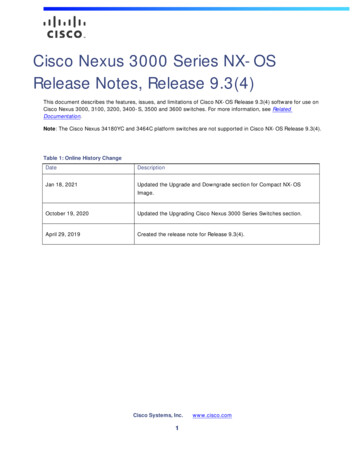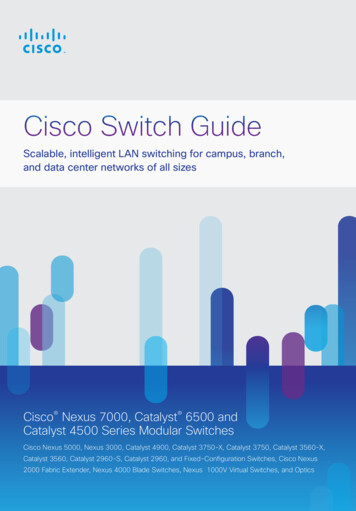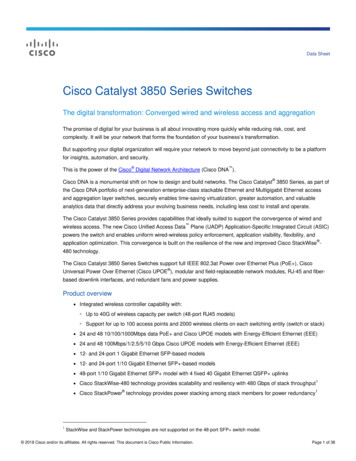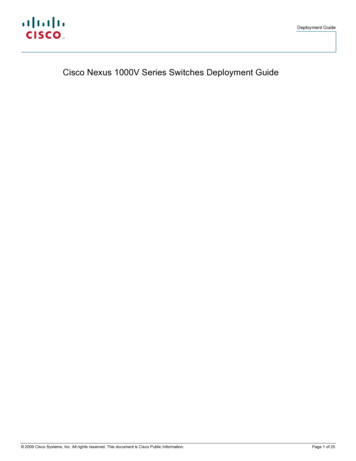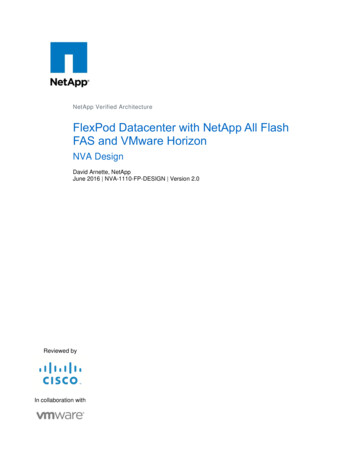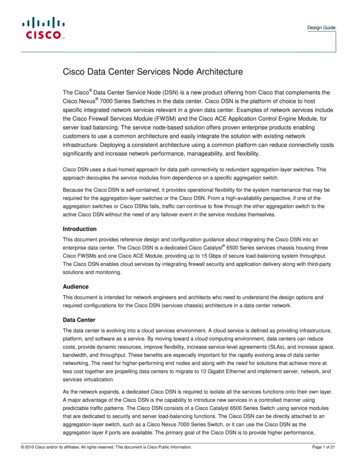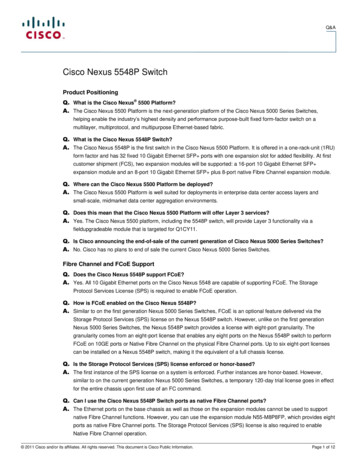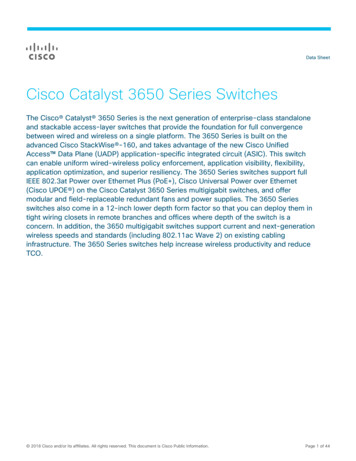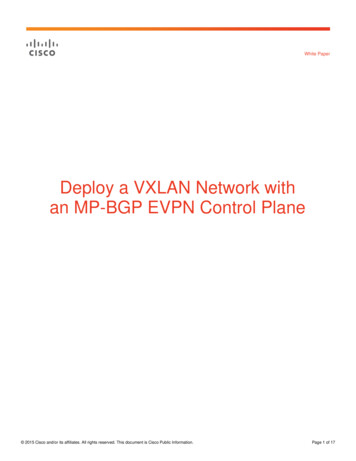
Transcription
White PaperDeploy a VXLAN Network withan MP-BGP EVPN Control Plane 2015 Cisco and/or its affiliates. All rights reserved. This document is Cisco Public Information.Page 1 of 17
ContentsIntroduction . 3MP-BGP EVPN Control Plane: Overview . 4Software and Hardware Support for the MP-BGP EVPN Control Plane . 4IP Transport Devices Running MP-BGP EVPN . 4IP Transport Devices Not Running MP-BGP EVPN . 5VTEPs Running MP-BGP EVPN . 5Inter-VXLAN Routing . 5MP-BGP EVPN VXLAN Support on Cisco Nexus 9000 Series Switches . 5MP-BGP EVPN VXLAN Support on Cisco Nexus 7000 Series and 7700 Platform Switches . 6Multitenancy in MP-BGP EVPN . 6MP-BGP EVPN NLRI and L2VPN EVPN Address Family . 6Integrated Routing and Bridging with the MP-BGP EVPN Control Plane . 8Local-Host Learning . 8EVPN Route Advertisement and Remote-Host Learning . 9Symmetric and Asymmetric Integrated Routing and Bridging . 9VNIs for Bridge Domains and IP VRF Instances . 12VTEP Peer Discovery and Authentication in MP-BGP EVPN . 13Distributed Anycast Gateway in MP-BGP EVPN . 15ARP Suppression in MP-BGP EVPN . 16Conclusion . 17For More Information . 17 2015 Cisco and/or its affiliates. All rights reserved. This document is Cisco Public Information.Page 2 of 17
IntroductionVirtual Extensible LAN (VXLAN) is an overlay technology for network virtualization. It provides Layer 2 extensionover a shared Layer 3 underlay infrastructure network by using MAC address in IP User Datagram Protocol(MAC in IP/UDP) tunneling encapsulation. The purpose of obtaining Layer 2 extension in the overlay network is toovercome the limitations of physical server racks and geographical location boundaries and achieve flexibility forworkload placement within a data center or between different data centers.The initial IETF VXLAN standards (RFC 7348) defined a multicast-based flood-and-learn VXLAN without a controlplane. It relies on data-based flood-and-learn behavior for remote VXLAN tunnel endpoint (VTEP) peer discoveryand remote end-host learning. The overlay broadcast, unknown unicast, and multicast traffic is encapsulated intomulticast VXLAN packets and transported to remote VTEP switches through the underlay multicast forwarding.Flooding in such a deployment can present a challenge for the scalability of the solution. The requirement toenable multicast capabilities in the underlay network also presents a challenge because some organizations do notwant to enable multicast in their data centers or WAN networks.To overcome the limitations of the flood-and-learn VXLAN as defined in RFC 7348, organizations can useMultiprotocol Border Gateway Protocol (MP-BGP) Ethernet Virtual Private Network (EVPN) as the control planefor VXLAN. MP-BGP EVPN has been defined by IETF as the standards-based control plane for VXLAN overlays.The MP-BGP EVPN control plane provides protocol-based VTEP peer discovery and end-host reachabilityinformation distribution that allows more scalable VXLAN overlay network designs suitable for private and publicclouds. The MP-BGP EVPN control plane introduces a set of features that reduces or eliminates traffic flooding inthe overlay network and enables optimal forwarding for both east-west and north-south traffic.This document discusses the functions and configuration of MP-BGP EVPN and describes typical VXLAN overlaynetwork designs using MP-BGP EVPN.This document does not discuss the fundamentals of VXLAN, VXLAN in multicast-based flood-and-learn mode,or related network design options. For more information about VXLAN and VXLAN with multicast-based flood-andlearn mode, please refer to the following documents: VXLAN Overview: Cisco Nexus 9000 Series paper-c11729383.html VXLAN Design with Cisco Nexus 9300 Platform paper-c11732453.html VXLAN Design with Cisco Nexus 5600 Platform paper-c11733618.htmlThis document assumes prior knowledge about BGP, MP-BGP, and BGP and Multiprotocol Label Switching(BGP/MPLS) IP VPN. For more information, refer to the following IETF RFC documents: RFC 4271 - Border Gateway Protocol 4 (BGP-4): https://tools.ietf.org/html/rfc4271 RFC 4760 - Multiprotocol Extensions for BGP-4: https://tools.ietf.org/html/rfc4760 RFC 4364 - BGP/MPLS IP VPNs: https://tools.ietf.org/html/rfc4364#page-15 2015 Cisco and/or its affiliates. All rights reserved. This document is Cisco Public Information.Page 3 of 17
MP-BGP EVPN Control Plane: OverviewMP-BGP EVPN is a control protocol for VXLAN based on IETF RFC 7342. Prior to EVPN, VXLAN overlaynetworks operated using the flood-and-learn model. In this model, end-host information learning and VTEPdiscovery are both data-plane based, with no control protocol to distribute end-host reachability information amongVTEPs. MP-BGP EVPN changes this model. It introduces control-plane learning for end hosts behind remoteVTEPs. It provides control-plane and data-plane separation and a unified control plane for both Layer 2 and Layer3 forwarding in a VXLAN overlay network.The MP-BGP EVPN control plane offers the following main benefits: The MP-BGP EVPN protocol is based on industry standards, allowing multivendor interoperability. It enables control-plane learning of end-host Layer 2 and Layer 3 reachability information, enablingorganizations to build more robust and scalable VXLAN overlay networks. It uses the very well known MP-BGP VPN technology to support scalable multitenant VXLAN overlaynetworks. The EVPN address family carries both Layer 2 and Layer 3 reachability information, thus providingintegrated bridging and routing in VXLAN overlay networks. It reduces network flooding through protocol-based host MAC/IP route distribution and Address ResolutionProtocol (ARP) suppression on the local VTEPs. It provides optimal forwarding for east-west and north-south traffic and supports workload mobility with thedistributed anycast gateway function. It provides VTEP peer discovery and authentication, mitigating the risk of rogue VTEPs in the VXLANoverlay network. It provides mechanisms for building active-active multihoming at Layer 2.Software and Hardware Support for the MP-BGP EVPN Control PlaneDepending on the role a device plays in a MP-BGP EVPN VXLAN network, it may need to support only the controlplane functions or both the control-plane and data-plane functions of the VXLAN network with the MP-BGP EVPNcontrol plane.IP Transport Devices Running MP-BGP EVPNIP transport devices provide IP routing in the underlay network. By running the MP-BGP EVPN protocol, theybecome part of the VXLAN control plane and distribute the MP-BGP EVPN routes among their MP-BGP EVPNpeers. Devices can be MP Internal BGP (MP-iBGP) EVPN peers (or route reflectors [[RRs]), or MP External BGP(MP-eBGP) EVPN peers. Their OS software needs to support MP-BGP EVPN network layer reachabilityinformation (NLRI) so that the OS can understand the MP-BGP EVPN updates and distribute them to otherMP-BGP EVPN peers using the standards-defined constructs. The most common example of such a function isthe BGP route reflector running in the spine layer. 2015 Cisco and/or its affiliates. All rights reserved. This document is Cisco Public Information.Page 4 of 17
IP Transport Devices Not Running MP-BGP EVPNIP transport devices play a role only in the underlay network by providing underlay Layer 3 routing and possiblyunderlay multicast rendezvous point (RP) functions. They do not contain VTEPs, nor do they play a role within theoverlay. Because these devices don’t need to provide functions specific to the EVPN address family withinMP-BGP or data-plane awareness of the VXLAN encapsulation, they can be any networking devices that meetthe required Layer 3 routing and multicast requirements of the VXLAN-enabled switches and routers. The mostcommon examples of such devices are in the spine layer of the network.VTEPs Running MP-BGP EVPNVTEPs running MP-BGP EVPN need to support both the control-plane and data-plane functions. In the controlplane, they initiate MP-BGP EVPN routes to advertise their local hosts. They also receive MP-BGP EVPN updatesfrom their peers and install the EVPN routes in their forwarding tables. For data forwarding, they encapsulate usertraffic in VXLAN and send it over the IP underlay network. In the reverse direction, they receive VXLANencapsulated traffic from other VTEPs, decapsulate it, and forward the traffic with native Ethernet encapsulationtoward the host.The correct switch platforms need to be selected for the different network roles. For IP transport devices, thesoftware needs to support the MP-EVPN control plane, but the hardware doesn’t need to support VXLAN dataplane functions. For VTEP support, the switch needs to support both the control-plane and data-plane functions.For spines that provide only the IP underlay for the VXLAN fabric, almost any switch or router that supports thechosen routing protocol and multicast traffic can be used.Inter-VXLAN RoutingThe MP-BGP EVPN control plane provides integrated routing and bridging by distributing both the Layer 2(MAC address) and Layer 3 (IP address) reachability information for end hosts and IP prefixes on VXLAN overlaynetworks. Communication between hosts in different subnets requires inter-VXLAN routing. BGP EVPN enablesthis communication by distributing Layer 3 reachability information in the form of either a host IP address route oran IP address prefix. In the data plane, the VTEP needs to support IP address route lookup and perform VXLANencapsulation based on that lookup. This capability is referred to as the VXLAN routing function. Not all switchhardware platforms support VXLAN routing, thus affecting the choice of hardware platform.MP-BGP EVPN VXLAN Support on Cisco Nexus 9000 Series SwitchesThe MP-BGP EVPN control plane for VXLAN was introduced in Cisco NX-OS Software Release 7.0(3)I1(1) forCisco Nexus 9000 Series Switches. In NX-OS 7.0(3)I1(1), the Cisco Nexus 9300 platform switches support boththe MP-BGP EVPN control-plane functions and the VTEP data-plane functions.The Cisco Nexus 9500 platform switches support both the MP-BGP EVPN control-plane and data-plane functionsstarting in NX-OS Software Release 7.0(3)I1(2). In NX-OS Software Release 7.0(3)I1(1) the Cisco Nexus 9500platform switches only support the control-plane functions. 2015 Cisco and/or its affiliates. All rights reserved. This document is Cisco Public Information.Page 5 of 17
MP-BGP EVPN VXLAN Support on Cisco Nexus 7000 Series and 7700 Platform SwitchesIn NX-OS 7.2(0)D1(1), the Cisco Nexus 7000 Series Switches and 7700 platform added MP-BGP VXLAN support,allowing them to participate in both the control plane and the data plane. With the Cisco Nexus F3-Series line card,full data-plane capability is possible. Without an F3-Series line card, control-plane capability is still possible.Today, the Cisco Nexus 7000 Series or 7700 platform switch can be a MP-BGP route reflector (with or without theF3-Series line card), VXLAN Layer 3 gateway, border leaf, spine, or border spine. In NX-OS 7.2, the Cisco Nexus7000 Series or 7700 platform switch in the border leaf or border spine role can either hand off to Cisco Locator/IDSeparation Protocol (LISP) or use Virtual Routing and Forwarding Lite (VRF-Lite).NX-OS 7.2 does not support leaf functionality. Therefore, Layer 2 VXLAN Overlay features are not supported.This support will be added in a future release.Multitenancy in MP-BGP EVPNIn an extension to the existing MP-BGP, MP-BGP EVPN inherits the support for multitenancy with VPN using theVRF construct. In MP-BGP EVPN, multiple tenants can co-exist and share a common IP transport network whilehaving their own separate VPNs in the VXLAN overlay network.In the EVPN VXLAN overlay network, VXLAN network identifiers (VNIs) define the Layer 2 domains and enforceLayer 2 segmentation by not allowing Layer 2 traffic to traverse VNI boundaries. Similarly, Layer 3 segmentationamong VXLAN tenants is achieved by applying Layer 3 VRF technology and enforcing routing isolation betweentenants by using a separate Layer 3 VNI mapped to each VRF instance. Each tenant has its own VRF routinginstance. IP subnets of the VNIs for a given tenant are in the same Layer 3 VRF instance that separates the Layer3 routing domain from the other tenants.For example, tenant A is assigned layer segment (VNIs) 10000 to 10004. All five VNIs are assigned to VRF A.Tenant B is assigned VNIs 10010 to 10014, and all VNIs are assigned to VRF B. With this assignment in place, allVNIs are routed through the same underlay network topology, but tenant A’s VNIs will not be able to communicatewith tenant B’s VNIs.Built-in multitenancy support is an advantage of MP-BGP EVPN VXLAN compared to multicast-based flood-andlearn VXLAN and other Layer 2 extension technologies without multitenancy capabilities. It makes VXLANtechnology more suitable for cloud networks, which are deployed using the multitenant model.MP-BGP EVPN NLRI and L2VPN EVPN Address FamilyLike other network routing control protocols, MP-BGP EVPN is designed to distribute network layer reachabilityinformation, or NLRI, for the network. A unique feature of EVPN NLRI is that it includes both the Layer 2 and Layer3 reachability information for end hosts that reside in the EVPN VXLAN overlay network. In other words, itadvertises both the MAC and IP addresses of EVPN VXLAN end hosts. This capability forms the basis for VXLANintegrated routing and bridging support.Layer 2 MAC addresses need to be distributed because VXLAN is a Layer 2 extension technology. Unlike atraditional VLAN, which is confined to a specific location in a network that remains within the Layer 2 and Layer 3boundary, a VNI is a virtual Layer 2 segment in the overlay network. However, from the underlay network’s point ofview, the VNI can span multiple noncontiguous sites, reaching beyond the Layer 2 and Layer 3 boundaries of theunderlay infrastructure (Figure 1). Traffic between end hosts in the same VNI needs to be bridged in the overlaynetwork. Therefore, VTEP devices in a given VNI need to know about other MAC addresses of end hosts in thisVNI. Distribution of MAC addresses through BGP EVPN allows unknown unicast flooding in the VXLAN to bereduced. 2015 Cisco and/or its affiliates. All rights reserved. This document is Cisco Public Information.Page 6 of 17
Note:VXLAN with a MP-BGP EVPN control plane supports MAC address-only routes. The IP information isoptional for route-type 2 (MAC and IP address advertisement) and can result in redundant MAC address routeobjects in the route information base (MAC address advertisement and MAC and IP address advertisement).Figure 1.VNI across an Underlay IP NetworkRFC 7342 defines a standards-based way of advertising Layer 3 host IP addresses through MP-BGP EVPN sothat inter-VXLAN traffic can be routed to the destination end host through an optimal path. For inter-VXLAN trafficthat needs to be routed to the destination end host, host-based IP routing can provide the optimal forwarding pathto the destination host. The following is an example of a MAC and IP address host advertisement in MP-BGPEVPN:Example Type-2 Route:Route Distinguisher: 10.1.1.13:32967(L2VNI 30200)* 1610.1.1.1346550032768 iMP-BGP EVPN can also advertise the IP subnet prefix routes of VNIs. The prefix routes can be used to routetraffic to the destination hosts when the host IP routes are missing: for instance, when the host IP routes have yetto be learned by the VTEPs through MP-BGP. VTEP can also advertise the prefix routes to outside the VXLANnetwork if the subnets need to be routable and made known outside the VXLAN network.The EVPN NLRI is carried in BGP using the BGP multiprotocol extension with a new address family called Layer 2VPN (L2VPN) EVPN. Similar to the VPNv4 address family in the BGP MPLS-based IP VPN (RFC 4364), theL2VPN EVPN address family for EVPN uses route distinguishers (RDs) to maintain uniqueness among identicalroutes in different VRF instances, and route targets (RTs) to define the policies that determine how routes areadvertised and shared by different VRF instances.A route distinguisher is an 8-bit octet number used to distinguish one set of routes (one VRF instance) fromanother. It is a unique number prepended to each route so that if the same route is used in several different VRFinstances, BGP can treat them as distinct routes. The route distinguisher is transmitted along with the routethrough MP-BGP when EVPN routes are exchanged with MP-BGP peers.Route targets can be applied to a VRF instance to control the import and export of routes between this instanceand other VRF instances. The route-target attributes for a route are distributed in the form of a BGP extendedcommunity attribute, so the BGP configuration on the devices that run MP-BGP EVPN must be enabled togenerate or process extended community attributes. 2015 Cisco and/or its affiliates. All rights reserved. This document is Cisco Public Information.Page 7 of 17
In the NX-OS implementation, the BGP route distinguisher and route target can be generated automatically forease of configuration. The BGP route distinguisher can be derived automatically from the VNI and BGP router ID ofthe VTEP switch, and the BGP route target can be generated automatically as the BGP autonomous system (AS)VNI. Alternatively, you can manually configure the BGP route distinguisher and route target.If all the MP-BGP EVPN VTEPs in a network are Cisco Nexus switch platforms, the recommended approach is touse autogenerated route-distinguisher and route-target values. If multiple vendors’ VTEP devices areinteroperating, the recommended approach is to manually configure the values to avoid possible problems causedby the differences in vendors’ implementations. For eBGP deployment scenarios in which VTEPs are in differentBGP domains, the BGP route targets must be manually assigned.Integrated Routing and Bridging with the MP-BGP EVPN Control PlaneThe MP-BGP EVPN control plane provides integrated routing and bridging by distributing both Layer 2 and Layer 3reachability information for the end host residing in the VXLAN overlay networks. Each VTEP performs locallearning to obtain MAC and IP address information from its locally attached hosts and then distributes thisinformation through the MP-BGP EVPN control plane. Hosts attached to remote VTEPs are learned remotelythrough the MP-BGP control plane. This approach reduces network flooding for end-host learning and providesbetter control over end-host reachability information distribution.Figure 2 shows an example of end-host NLRI learning and distribution in an MP-iBGP EVPN using route reflectors.Figure 2.MP-BGP EVPN Host NLRI Learning and DistributionLocal-Host LearningA VTEP in MP-BGP EVPN learns the MAC addresses and IP addresses of locally attached end hosts through locallearning. This learning can be local-data-plane based using the standard Ethernet and IP learning procedures,such as source MAC address learning from the incoming Ethernet frames and IP address learning when the hostssend Gratuitous ARP (GARP) and Reverse ARP (RARP) packets or ARP requests for the gateway IP address onthe VTEP. Alternatively, the learning can be achieved by using a control plane or through management-planeintegration between the VTEP and the local hosts. 2015 Cisco and/or its affiliates. All rights reserved. This document is Cisco Public Information.Page 8 of 17
EVPN Route Advertisement and Remote-Host LearningAfter learning the local-host MAC and IP addresses, a VTEP advertises the host information in the MP-BGP EVPNcontrol plane so that this information can be distributed to other VTEPs. This approach enables EVPN VTEPs tolearn the remote end hosts in the MP-BGP EVPN control plane.The EVPN routes are advertised through the L2VPN EVPN address family. The BGP L2VPN EVPN routes includethe following information: RD: Route distinguisher MAC address length: 6 bytes MAC address: Host MAC address IP address length: 32 or 128 IP address: Host IP address (IPv4 or IPv6) L2 VNI: VNI of the bridge domain to which the end host belongs L3 VNI: VNI associated with the tenant VRF routing instanceMP-BGP EVPN uses the BGP extended community attribute to transmit the exported route targets in an EVPNroute. When an EVPN VTEP receives an EVPN route, it compares the route-target attributes in the received routeto its locally configured route-target import policy to decide whether to import or ignore the route. This approachuses the MP-BGP VPN standard (RFC 4364) and provides scalable multitenancy in which a node that does nothave a VRF locally does not import the corresponding routes. VPN scaling can be further enhanced by the use ofBGP constructs such as route-target-constrained route distribution (RFC 4684).When a VTEP switch originates MP-BGP EVPN routes for its locally learned end hosts, it uses its own VTEPsource address as the BGP next hop. This BGP next hop must remain unchanged through the route distributionacross the network because the remote VTEP must learn the originating VTEP address as the next hop for VXLANencapsulation when forwarding packets for the overlay network.The underlay network provides IP reachability for all the VTEP addresses that are used to route the encapsulatedVXLAN packets toward the egress VTEP through the underlay network. The network devices in the underlaynetwork need to maintain routing information only for the VTEP addresses. They don’t need to learn the EVPNroutes. This approach simplifies the underlay network operation and increases its stability and scalability.Symmetric and Asymmetric Integrated Routing and BridgingThe IETF EVPN drafts (RFC 7432) define two integrated routing and bridging (IRB) models: asymmetric IRB andsymmetric IRB. NX-OS for the Cisco Nexus Family switches implements symmetric IRB for its scalabilityadvantages and simplified Layer 2 and Layer 3 multitenancy support.Asymmetric IRBWith asymmetric IRB, the ingress VTEP performs both Layer 2 bridging and Layer 3 routing lookup, whereas theegress VTEP performs only Layer 2 bridging lookup. As shown in Figure 3, with asymmetric IRB, when a packettravels between two VNIs, the ingress VTEP routes the packet from the source VNI to the destination VNI.The egress VTEP bridges the packet to the destination point within the destination VNI. 2015 Cisco and/or its affiliates. All rights reserved. This document is Cisco Public Information.Page 9 of 17
Figure 3.VXLAN Routing with Asymmetric IRBAsymmetric IRB requires the ingress VTEP to be configured with both the source and destination VNIs for bothLayer 2 and Layer 3 forwarding. Essentially, it requires every VTEP to be configured with all VNIs in the VXLANnetwork and to learn ARP entries and MAC addresses for all the end hosts attached to those VNIs (Figure 4).This behavior can cause scalability problems as the density of end hosts or the number of VXLAN VNIs in theoverlay network increases.Figure 4.VTEP VNI Membership in Asymmetric IRBSymmetric IRBWith symmetric IRB, both the ingress and egress VTEPs perform Layer 2 and Layer 3 lookups. Symmetric IRBintroduces a few new logical constructs: Layer 3 VNI: Each tenant VRF instance is mapped to a unique Layer 3 VNI in the network. This mappingneeds to be consistent on all the VTEPs in the network. All inter-VXLAN routed traffic is encapsulated withthe Layer 3 VNI in the VXLAN header and provides the VRF context for the receiving VTEP. The receivingVTEP uses this VNI to determine the VRF context in which the inner IP packet needs to be forwarded. ThisVNI also provides the basis for enforcing Layer 3 segmentation in the data plane. 2015 Cisco and/or its affiliates. All rights reserved. This document is Cisco Public Information.Page 10 of 17
VTEP router MAC address: Each VTEP has a unique system MAC address that other VTEPs can use forinter-VNI routing. This MAC address is referred to here as the router MAC address. The router MACaddress is used as the inner destination MAC address for the routed VXLAN packet.As shown in Figure 5, when a packet is sent from VNI A to VNI B, the ingress VTEP routes the packet to the Layer3 VNI. It rewrites the inner destination MAC address to the egress VTEP’s router MAC address and encodes theLayer 3 VNI in the VXLAN header. After the egress VTEP receives the encapsulated VXLAN packet, it firstdecapsulates the packet by removing the VXLAN header. Then it looks at the inner packet header. Because thedestination MAC address in the inner packet header is its own MAC address, it performs a Layer 3 routing lookup.The Layer 3 VNI in the VXLAN header provides the VRF context in which this routing lookup is performed.Figure 5.VXLAN Routing with Symmetric IRBAdvantages of Symmetric IRBWith symmetric IRB, the ingress VTEP doesn’t need to know the destination VNI for inter-VNI routing. Therefore,VTEPs don’t need to learn and maintain MAC address information for the remote hosts attached to egress VNIs forwhich they don’t have local hosts (Figure 6). This approach results in better utilization of the MAC address tableand ARP adjacencies on a VTEP. For example, in Figure 6 all host MAC address and ARP adjacencies in VLAN200 and VNI 5200 do not need to be present in the leftmost VTEP. As a result, routing and bridging is morescalable than with asymmetric IRB. NX-OS implements symmetric IRB to achieve optimal learning and scaling.In addition, with symmetrical IRB you can choose to scope switch configurations so that they have switch virtualinterfaces (SVIs) only for segments that are located behind the respective switch, thus enabling an optimizedconfiguration. 2015 Cisco and/or its affiliates. All rights reserved. This document is Cisco Public Information.Page 11 of 17
Figure 6.VTEP VNI Membership with Symmetric IRBVNIs for Bridge Domains and IP VRF InstancesAn EVPN VXLAN tenant can have multiple Layer 2 networks, each with a corresponding VNI. These Layer 2networks are bridge domains in the overlay network. The VNIs that are associated with them are often referred toas Layer 2 (L2) VNIs. If VXLAN routing is required, then each tenant also needs a Layer 3 (L3) VNI in symmetricIRB. Although a VTEP can have all or a subset of the Layer 2 VNIs in a VXLAN EVPN overlay, it must have theLayer 3 VNI for inter-VXLAN routing. All VTEPs in an EVPN must have the same Layer 3 VNI (Figure 7).Figure 7.VNIs for Bridge Domain and IP VRF InstancesLayer 2 Bridging in an EVPN VXLAN FabricWhen the destination MAC address in the original packet header does not belong to the local VTEP, then VXLANbridging needs to occur. In other words, the originating VTEP will perform a Layer 2 lookup and bridge the packetto the destination VTEP. 2015 Cisco and/or its affiliates. All rights reserved. This document is Cisco Public Information.Page 12 of 17
Layer 3 Routing in an EVPN VXLAN FabricIf the destination MAC address matches the anycast gateway MAC address, then VXLAN routing needs to occur.In this case, the originating VTEP will perform a Layer 3 lookup and then encapsulate the packet with the Layer 3VNI. The destination VTEP will then receive the traffic and will perform another routing lookup based on the innerIP header. The destination VTEP knows to perform this step because the destination MAC address in the packetbelongs to the destination VTEP itself.The destination VTEP address, which resides in the outer IP header of a VXLAN packet, identifies the location ofthe destination host in the underlay network. VXLAN packets are routed toward the egress VTEP through theunderl
With the Cisco Nexus F3-Series line card, full data-plane capability is possible. Without an F3-Series line card, control-plane capability is still possible. Today, the Cisco Nexus 7000 Series or 7700 platform switch can be a MP-BGP route reflector (with or without the F3-Series line card), VXLAN Layer 3 gateway, border leaf, spine, or border .
